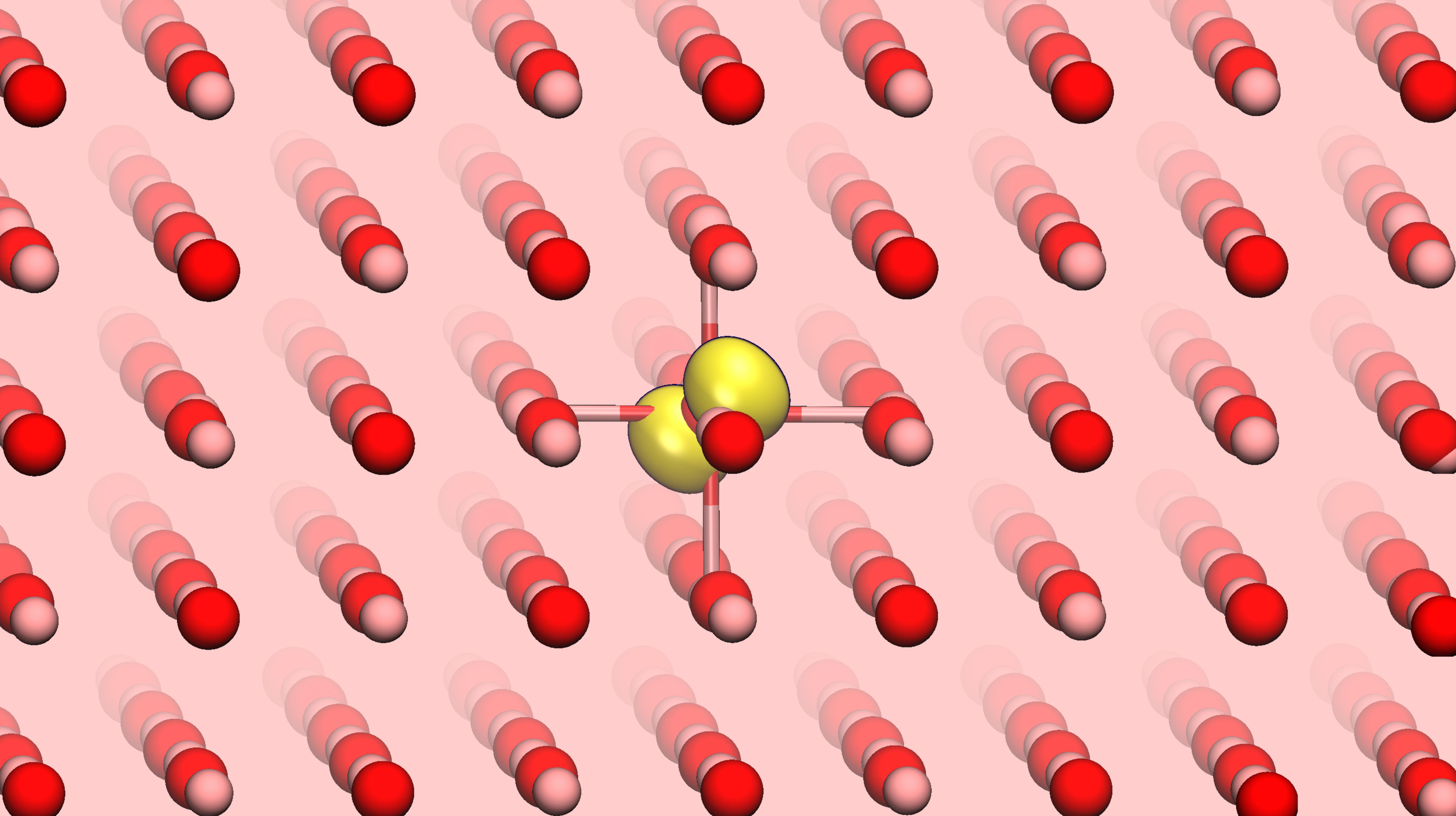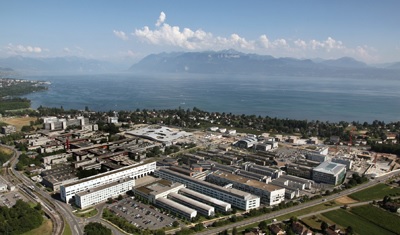10.7.22
Papageorgiou

Physicists at EPFL have developed a formulation to solve the longstanding problem of electron self-interaction when studying polarons – quasiparticles produced by electron-phonon interactions in materials. The work can lead to unprecedented calculations of polarons in large systems, systematic studies of large sets of materials, and molecular dynamics evolving over long time periods.
One of the many peculiarities of quantum mechanics is that particles can also be described as waves. A common example is the photon, the particle associated with light.
In ordered structures, known as crystals, electrons can be seen and described as waves that spread across the entire system – a rather harmonious picture. As electrons move through the crystal, ions – atoms carrying a negative or positive charge — are periodically arranged in space.
Now, if we were to add an extra electron to the crystal, its negative charge could make the ions around it move away from their equilibrium positions. The electron charge would localize in space and couple to the surrounding structural – “lattice” – distortions of the crystal, giving rise to a new particle known as a polaron.
“Technically, a polaron is a quasi-particle, made up of an electron “dressed” by its self-induced phonons, which represent the quantized vibrations of the crystal,” says Stefano Falletta at EPFL’s School of Basic Sciences. He continues: “The stability of polarons arises from a competition between two energy contributions: the gain due to charge localization, and the cost due to lattice distortions. When the polaron destabilizes, the extra electron delocalizes over the entire system, while the ions restore their equilibrium positions.”

A polaron forming in magnesium oxide atoms. Credit: S. Falletta (EPFL)
Working with Professor Alfredo Pasquarello at EPFL, they have published two papers in Physical Review Letters [below] and Physical Review B [below] describing a new approach for solving a major shortcoming of a well-established theory that physicists use to study the interactions of electrons in materials. The method is called density functional theory or DFT, and is used in physics, chemistry, and materials science to study the electronic structure of many-body systems like atoms and molecules.
DFT is a powerful tool for performing ab-initio calculations of materials, by simplified treatment of the electron interactions. However, DFT is susceptible to spurious interactions of the electron with its own self – what physicists refer to as the “self-interaction problem”. This self-interaction is one of the greatest limitations of DFT, often leading to incorrect description of polarons, which are often destabilized.
“In our work, we introduce a theoretical formulation for the electron self-interaction that solves the problem of polaron localization in density functional theory,” says Falletta. “This gives access to accurate polaron stabilities within a computationally-efficient scheme. Our study paves the way to unprecedented calculations of polarons in large systems, in systematic studies involving large sets of materials, or in molecular dynamics evolving over long time periods.”
Science papers:
Physical Review Letters
Physical Review B
See the full article here .
five-ways-keep-your-child-safe-school-shootings
Please help promote STEM in your local schools.
The Swiss Federal Institute of Technology in Lausanne [EPFL-École Polytechnique Fédérale de Lausanne] (CH) is a research institute and university in Lausanne, Switzerland, that specializes in natural sciences and engineering. It is one of the two Swiss Federal Institutes of Technology, and it has three main missions: education, research and technology transfer.
The QS World University Rankings ranks EPFL(CH) 14th in the world across all fields in their 2020/2021 ranking, whereas Times Higher Education World University Rankings ranks EPFL(CH) as the world’s 19th best school for Engineering and Technology in 2020.
EPFL(CH) is located in the French-speaking part of Switzerland; the sister institution in the German-speaking part of Switzerland is The Swiss Federal Institute of Technology ETH Zürich [Eidgenössische Technische Hochschule Zürich] (CH). Associated with several specialized research institutes, the two universities form The Domain of the Swiss Federal Institutes of Technology (ETH Domain) [ETH-Bereich; Domaine des Écoles Polytechniques Fédérales] (CH) which is directly dependent on the Federal Department of Economic Affairs, Education and Research. In connection with research and teaching activities, EPFL(CH) operates a nuclear reactor CROCUS; a Tokamak Fusion reactor; a Blue Gene/Q Supercomputer; and P3 bio-hazard facilities.
ETH Zürich, EPFL (Swiss Federal Institute of Technology in Lausanne) [École Polytechnique Fédérale de Lausanne](CH), and four associated research institutes form The Domain of the Swiss Federal Institutes of Technology (ETH Domain) [ETH-Bereich; Domaine des Écoles polytechniques fédérales] (CH) with the aim of collaborating on scientific projects.
The roots of modern-day EPFL(CH) can be traced back to the foundation of a private school under the name École Spéciale de Lausanne in 1853 at the initiative of Lois Rivier, a graduate of the École Centrale Paris (FR) and John Gay the then professor and rector of the Académie de Lausanne. At its inception it had only 11 students and the offices were located at Rue du Valentin in Lausanne. In 1869, it became the technical department of the public Académie de Lausanne. When the Académie was reorganized and acquired the status of a university in 1890, the technical faculty changed its name to École d’Ingénieurs de l’Université de Lausanne. In 1946, it was renamed the École polytechnique de l’Université de Lausanne (EPUL). In 1969, the EPUL was separated from the rest of the University of Lausanne and became a federal institute under its current name. EPFL(CH), like ETH Zürich (CH), is thus directly controlled by the Swiss federal government. In contrast, all other universities in Switzerland are controlled by their respective cantonal governments. Following the nomination of Patrick Aebischer as president in 2000, EPFL(CH) has started to develop into the field of life sciences. It absorbed the Swiss Institute for Experimental Cancer Research (ISREC) in 2008.
In 1946, there were 360 students. In 1969, EPFL(CH) had 1,400 students and 55 professors. In the past two decades the university has grown rapidly and as of 2012 roughly 14,000 people study or work on campus, about 9,300 of these being Bachelor, Master or PhD students. The environment at modern day EPFL(CH) is highly international with the school attracting students and researchers from all over the world. More than 125 countries are represented on the campus and the university has two official languages, French and English.
Organization
EPFL is organized into eight schools, themselves formed of institutes that group research units (laboratories or chairs) around common themes:
School of Basic Sciences
Institute of Mathematics
Institute of Chemical Sciences and Engineering
Institute of Physics
European Centre of Atomic and Molecular Computations
Bernoulli Center
Biomedical Imaging Research Center
Interdisciplinary Center for Electron Microscopy
MPG-EPFL Centre for Molecular Nanosciences and Technology
Swiss Plasma Center
Laboratory of Astrophysics
School of Engineering
Institute of Electrical Engineering
Institute of Mechanical Engineering
Institute of Materials
Institute of Microengineering
Institute of Bioengineering
School of Architecture, Civil and Environmental Engineering
Institute of Architecture
Civil Engineering Institute
Institute of Urban and Regional Sciences
Environmental Engineering Institute
School of Computer and Communication Sciences
Algorithms & Theoretical Computer Science
Artificial Intelligence & Machine Learning
Computational Biology
Computer Architecture & Integrated Systems
Data Management & Information Retrieval
Graphics & Vision
Human-Computer Interaction
Information & Communication Theory
Networking
Programming Languages & Formal Methods
Security & Cryptography
Signal & Image Processing
Systems
School of Life Sciences
Bachelor-Master Teaching Section in Life Sciences and Technologies
Brain Mind Institute
Institute of Bioengineering
Swiss Institute for Experimental Cancer Research
Global Health Institute
Ten Technology Platforms & Core Facilities (PTECH)
Center for Phenogenomics
NCCR Synaptic Bases of Mental Diseases
College of Management of Technology
Swiss Finance Institute at EPFL
Section of Management of Technology and Entrepreneurship
Institute of Technology and Public Policy
Institute of Management of Technology and Entrepreneurship
Section of Financial Engineering
College of Humanities
Human and social sciences teaching program
EPFL Middle East
Section of Energy Management and Sustainability
In addition to the eight schools there are seven closely related institutions
Swiss Cancer Centre
Center for Biomedical Imaging (CIBM)
Centre for Advanced Modelling Science (CADMOS)
École Cantonale d’art de Lausanne (ECAL)
Campus Biotech
Wyss Center for Bio- and Neuro-engineering
Swiss National Supercomputing Centre



